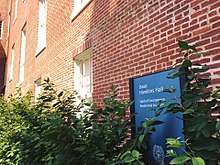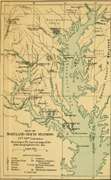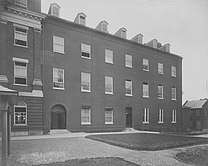1838 Jesuit slave sale
In 1838, 272 men, women, and children were sold by the Maryland Jesuits; a portion of the proceeds was used to pay the debts of Georgetown College (now Georgetown University), also run by the Jesuits. The slaves had lived on plantations belonging to the Jesuits in Maryland, and they were sold to Henry Johnson and Jesse Batey. The sale price was $115,000, equivalent to $2,761,078 in 2019.[1] Of the $25,000 down-payment, $17,000 was used to pay down building debt that Thomas F. Mulledy, the provincial superior who orchestrated the sale, had accrued as president of Georgetown College.[2][3][4]
        "Articles of agreement between Thomas F. Mulledy, on behalf of the Maryland Province of the Society of Jesus, and Henry Johnson and Jesse Batey" | |
| Date | June 19, 1838 |
|---|---|
| Organised by | Thomas F. Mulledy, William McSherry |
| Participants | Henry Johnson, Jesse Batey |
The slaves sold by the Jesuits were part of the West Oak and Chatham Plantations, in Louisiana, both of which would later change ownership.[5] None of the terms for the sale, directed from the Catholic Church leadership in Rome, was met. These terms included that there be no familial separation, that the proceeds not be used to pay debt or the operating expenses of the college, and that the religious practice of the enslaved people be supported. In 1848, the Jesuit James Van de Velde wrote to Mulledy about his concerns over the lack of religious instruction received by the slaves sold to Henry Johnson, and urged Mulledy to contribute funds for the construction of a chapel.[4][6]
Many descendants of these enslaved people (sometimes known as the "GU272") presently live in and around Maringouin, Louisiana.[2]
In April 2019, two-thirds of Georgetown students voted to establish a semesterly fee to fund reparations for descendants of the 272 enslaved people. The non-binding resolution was presented to the university for the approval of its board of directors.[7]
Context prior to sale
Georgetown College (later known as Georgetown University) was founded by John Carroll, the Bishop of Baltimore, in 1789.[8] In 1829, Thomas F. Mulledy was appointed the President of Georgetown College.[9]
Legacy
National revelations of this connection were reported in a 2016 article in The New York Times.[10] A discussion is ongoing addressing the question of reconciliation of the university and the descendants; an internal working group at Georgetown recommended that the university offer "the same consideration [they] give members of the Georgetown community in the admissions process" to the descendants.[11] In response to these issues, descendant groups have formed, including the GU 272 Descendants Association.[12]
Building renamings

After the revelation around the slave sale gained wider publicity, the university decided to rename two buildings that bore the names of two Jesuits at Georgetown who had played significant roles in the 1838 sale, Thomas Mulledy and William McSherry. In November 2015, Mulledy Hall was renamed Freedom Hall and McSherry Hall was renamed Remembrance Hall as temporary measures while other names were being considered.[13] In 2017, the two buildings were rededicated in the names of Isaac, the first slave listed in the 1838 sale document, and Anne Marie Becraft, a free woman of color who established a school in Georgetown for black girls.[14]
Isaac Hawkins Hall
Isaac was an enslaved man born around 1773 and is believed to have been baptized in 1777. Historical records do not provide a family name, so his descendants' surname Hawkins was assigned to him. Before the sale he lived on the Jesuits' White Marsh plantation near present-day Bowie, Maryland, and went on to have at least five children. He was 65 years old at the time of the sale in 1838. Most of his family members were also sold and were sent to Louisiana; his son Patrick arrived on the same ship as Isaac, and his grandson Cornelius was sent to Louisiana as well. His name does not appear on bills of sale from the 1850s that include his descendants, so Isaac is assumed to have died before then.[15] Isaac has living descendants as of 2017.[15][16]
Isaac was chosen to represent the entire group for the building renaming because his name was first on the list of enslaved people sold. Georgetown historian Maurice Jackson said, "We thought if we take the name of the first person, in which some ways he becomes representative of the other enslaved black people sold".[15][14] The building and an adjacent one had been built around 1833 and 1904, and housed Jesuits until 2004. After ten years of vacancy, they were renovated as student housing and opened in 2015.[17][18]
In the February 5, 2019 episode of PBS's Finding Your Roots, actress S. Epatha Merkerson was revealed to be a descendant of Isaac Hawkins.
Gallery
 Frank Campbell, one of the slaves sold in 1838, pictured c.1900
Frank Campbell, one of the slaves sold in 1838, pictured c.1900 Map of Jesuit stations in Maryland from the 17th to the 19th centuries
Map of Jesuit stations in Maryland from the 17th to the 19th centuries Slave manifest of the Katherine Jackson, the vessel used to transport slaves sold by Georgetown College to New Orleans in 1838
Slave manifest of the Katherine Jackson, the vessel used to transport slaves sold by Georgetown College to New Orleans in 1838 Mulledy Hall in 1898
Mulledy Hall in 1898
References
Citations
- "Archived copy". Archived from the original on May 1, 2017. Retrieved February 2, 2018.CS1 maint: archived copy as title (link)
- Quallen, Matthew. "Beyond the 272 Sold in 1838, Plotting the National Diaspora of Jesuit-Owned Slaves". The Hoya. Archived from the original on May 1, 2017. Retrieved April 28, 2017.
- King, Noel (April 26, 2017). "Georgetown, Louisiana, Part Two". Planet Money. Archived from the original on April 28, 2017. Retrieved April 28, 2017.
- "What We Know Booklet". Georgetown Slavery Archive. 2015. Archived from the original on February 3, 2018. Retrieved February 3, 2018.
- Champomier, P. A. (1861). "West Oak and Chatham plantations". Georgetown Slavery Archive. Archived from the original on February 3, 2018. Retrieved February 3, 2018.
- Van de Velde, James (March 28, 1848). "Letter from James Van de Velde, S.J. to Thomas Mulledy, S.J." Georgetown Slavery Archive. Archived from the original on June 3, 2017. Retrieved February 3, 2018.
- Jonnalagadda, Deepika (April 12, 2019). "Students Endorse Reconciliation Fee in GU272 Referendum". The Hoya. Georgetown, D.C. Retrieved April 12, 2019.
- "Georgetown's Catholic and Jesuit Identity". Georgetown University. February 15, 2008. Archived from the original on March 18, 2009. Retrieved November 26, 2019.
- Shea 1891, p. 79
- Swarns, Rachel L. (April 17, 2016). "272 Slaves Were Sold to Save Georgetown. What Does It Owe Their Descendants?". The New York Times. Archived from the original on March 6, 2017. Retrieved April 28, 2017.
- "Georgetown Shares Slavery, Memory, And Reconciliation Report, Racial Justice Steps". Georgetown University. September 1, 2016. Archived from the original on April 25, 2017. Retrieved April 28, 2017.
- "GU272 Descendants Association". Archived from the original on February 3, 2018. Retrieved February 3, 2018.
- Shaver, Katherine (November 15, 2015). "Georgetown University to rename two buildings that reflect school's ties to slavery". Washington Post. ISSN 0190-8286. Archived from the original on February 3, 2018. Retrieved February 2, 2018.
- Cloherty, Megan (April 18, 2017). "Georgetown University confronts past of slavery, rededicates 2 buildings". WTOP. Archived from the original on July 5, 2017. Retrieved February 2, 2018.
- "Georgetown to Rename Building for Isaac Hawkins, One of 272 Enslaved in 1838 Sale". Georgetown University. Retrieved February 2, 2018.
- Zauzmer, Julie (April 18, 2017). "Grappling with its history of slavery, Georgetown gathers descendants for a day of repentance". Washington Post. ISSN 0190-8286. Retrieved February 2, 2018.
- "Ryan and Isaac Hawkins Halls". Keast & Hood. Retrieved February 2, 2018.
- "Ryan Hall & Isaac Hawkins Hall". Georgetown University. Retrieved February 2, 2018.
Sources
- Kuzniewski, Anthony J. (1999). Thy Honored Name: A History of the College of the Holy Cross, 1843–1994. Washington, D.C.: Catholic University of America Press. ISBN 978-0-81320-911-1. Archived from the original on December 2, 2018. Retrieved November 25, 2019 – via Google Books.CS1 maint: ref=harv (link)
- Shea, John Gilmary (1891). "Chapter XVI: Father Thomas F. Mulledy". Memorial of the First Century of Georgetown College, D.C.: Comprising a History of Georgetown University. 3. Washington, D.C.: P. F. Collier. pp. 90–117, 154–162. OCLC 960066298. Archived from the original on December 2, 2018. Retrieved November 27, 2019 – via Google Books.CS1 maint: ref=harv (link)
